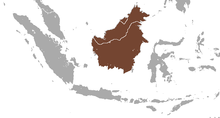Collared mongoose
Appearance
(Redirected from Collared Mongoose)
| Collared mongoose | |
|---|---|

| |
| Scientific classification | |
| Domain: | Eukaryota |
| Kingdom: | Animalia |
| Phylum: | Chordata |
| Class: | Mammalia |
| Order: | Carnivora |
| Suborder: | Feliformia |
| Family: | Herpestidae |
| Genus: | Urva |
| Species: | U. semitorquata
|
| Binomial name | |
| Urva semitorquata Gray, 1846
| |

| |
| Collared mongoose range | |
| Synonyms | |
|
Herpestes semitorquatus | |
The collared mongoose (Urva semitorquata) is a mongoose species native to Borneo and Sumatra; its presence in the Philippines is uncertain. It is listed as Near Threatened on the IUCN Red List.[1]
Taxonomy
[edit]Herpestes semitorquatus was the scientific name proposed by John Edward Gray in 1846 for a dark brown mongoose specimen collected in Borneo.[2] Mungos semitorquatus uniformis proposed by Herbert C. Robinson and Cecil Boden Kloss in 1919 were two collared mongooses collected in Ophir District, West Sumatra.[3] All Asian mongooses are now thought to belong in the genus Urva.[4]
Bornean and Sumatran collared mongooses exhibit little genetic divergence.[5]
References
[edit]- ^ a b Mathai, J.; Hearn, A.; Brodie, J.; Wilting, A.; Duckworth, J. W.; Ross, J.; Holden, J.; Gemita, E. & Hon, J. (2015). "Herpestes semitorquatus". IUCN Red List of Threatened Species. 2015: e.T41616A45208027.
- ^ Gray, J.E. (1846). "New species of Mammalia". The Annals and Magazine of Natural History; Zoology, Botany, and Geology. 18 (118): 211–212.
- ^ Robinson, H.C. & Kloss, C.B. (1919). "On mammals chiefly from the Ophir District, W.-Sumatra, collected by Mr. E. Jacobson". Journal of the Federated Malay States Museums. 7: 302.
- ^ "ASM Mammal Diversity Database". www.mammaldiversity.org. Retrieved 2021-07-08.
- ^ Veron, G.; Patou, M-L.; Debruyne, R.; Couloux, A.; Fernandez, D.A.P.; Wong, S.T.; Fuchs, J.; Jennings, A.P. (2015). "Systematics of the Southeast Asian mongooses (Herpestidae, Carnivora): solving the mystery of the elusive collared mongoose and Palawan mongoose". Zoological Journal of the Linnean Society. 173: 236–248. doi:10.1111/zoj.12110.

